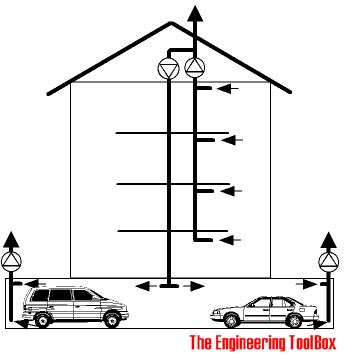Garage Ventilation
Exhaust ventilation from garages and workshops.
In a garage or workshop where exhaust gases like Carbon Monoxide (CO) and NOx from vehicles are very dangerous - proper ventilation is very important.
Garages or workshops with floor areas more than 500 ft2(50m2) should always have mechanical ventilation with fans. Smaller garages can have natural ventilation with evacuation of air through ducts with larger area than 0.2% of the floor area.
Required Air Changes per Hour
As a general rule of thumb the minimum
- air changes per hour in a storage garage should be least 4 to 6
- air changes per hour in a repair garage or workshop should be at least 20 to 30
The fresh air supply to the garage can be calculated as
Q = n V (1)
where
Q = total fresh air supply (m3/h)
n = required air changes per hour (h-1)
V = volume of the garage (m3)
CO Emission
Fresh air supply to a garage can be based on the CO emission from vehicles parked and driving through as
qCO = (20 + 0.1 l1) c1 + 0.1 c2 l2 (2)
where
qCO = CO emission from cars (m3/h)
c1 = capacity (numbers) of parked cars in the garage
l1 = mean driving distance for cars in the parking garage (m)
c2 = numbers of cars driving through the garage
l2 = mean driving distance for cars driving through the garage (m)
Required fresh air supply can be estimated with
Q = k qCO (3)
where
Q = required fresh air supply (m3/h)
k = application coefficient
Typical application coefficients:
- k = 2 where people are in the garage temporarily
- k = 4 where people are in the garage permanently - service shops or similar
Example - Fresh Air Supply to a Garage
Storage Garage - Fresh Air Supply
The fresh air supply to a storage garage with 10 cars, floor area 150 m2, volume 300 m3 and a mean driving distance for the cars of 20 m - can be calculated as
Required air changes per hour
Fresh air supply due to required 4 air changes per hour can be calculated as
Q= (4 1/h) (300 m3)
= 1200 m3/h
CO emission
CO emission can be calculated as
qCO = (20 + 0.1 (20 m)) (10 cars)
= 220 m3/h CO
Required air flow due to CO emission can be calculated as
Q= 2 (220 m3/h)
= 440 m3/h air
Comparing the two calculations - the fresh air supply should be at least 1200 m3/h.
Repair Garage - Fresh Air Supply
The fresh air supply to a repair garage with 10 cars, floor area 150 m2, volume 300 m3 and a mean driving distance for the cars of 20 m - can be calculated as
Required air changes per hour
Fresh air supply due to required 20 air changes per hour can be calculated as
Q= 20 (300 m3/h)
= 6000 m3/h
CO emission
CO emission can be calculated as
qCO = (20 + 0.1 (20 m)) (10 cars)
= 220 m3/h CO
Required air flow due to CO emission can be calculated as
Q= 4 (220 m3/h)
= 880 m3/h air
Comparing the two calculations the fresh air supply should be at least 6000 m3/h.
Local Codes
Local regulations and codes must always be adapted. It is important not to underestimate the influence of traffic in the garage on the required air flow.
- NOTE! - CO - Carbon Monoxide can be very dangerous!
Alternative Systems
A typical ventilation system for a smaller garage

The fresh air is supplied through openings in the outside wall. Polluted air is evacuated through openings close to the floor and the roof.
For larger buildings and garages it is common to use outlet air from the ventilation systems in the surrounding buildings as fresh make-up air to the garages.

Air with room temperature (or temperature after the heat recovery unit) is supplied to the garage. Polluted air is evacuated through openings close to the floor and the roof.
Related Topics
-
Ventilation Systems
Design of systems for ventilation and air handling - air change rates, ducts and pressure drops, charts and diagrams and more.
Related Documents
-
Air Change Rate
Calculate air change rates - equations in imperial and SI units. -
Air Change Rates in typical Rooms and Buildings
Fresh air (make up air) rquirements - or recommended air change rates (ACH) for typical rooms and buildings like auditoriums, kitchens, churches and more. -
Carbon Monoxide and Health Effects
Exposure to Carbon Monoxide - CO and health effects. -
Cars - New vs. Old Car Cost Calculator
Calculate and compare the costs between owning a new vs. an old car. -
Gases - Dangerous Concentration Levels
Dangerous vs. tolerable concentration levels for some industrial gases. -
Piston Engines - Compression Ratios
Cylinder volume and compression ratios in piston engines. -
Piston Engines - Displacement
Calculate piston engine displacement.




